Tuesday, September 15, 2009
Top Scorers on Rebounds, 2005-09
The NHL statistical database has been consistent for the four seasons since the lockout (Missed Shots were excluded in the two seasons prior to it). Here are the rebound scoring leaders:
The worst? Alexei Kovalev, with just one goal on 42 total rebounds...
Player Shot G SOG MS
Parise 73 22 41 10
Svatos 49 20 23 6
E Staal 81 19 50 12
Frolov 53 18 28 7
Antropov 50 17 26 7
Jokinen 73 17 43 13
Gomez 47 16 23 8
Zubrus 47 16 18 13
Arnott 54 16 29 9
D. Roy 56 16 28 12
Vermette 63 16 36 11
The worst? Alexei Kovalev, with just one goal on 42 total rebounds...
Friday, August 28, 2009
Defensive Systems and their Impact on Shot Location
As we saw a few weeks ago, Jacques Lemaire’s defensive system substantially limits the rate at which opponents take high-percentage shots against his teams. This effect has been persistent over the course of nearly a decade. This made me wonder what impact other coaches have on shots faced by their teams.
What the chart below shows is - for each coach in all years that he coached - the difference between league-wide save percentage and the save percentage each team expected given the shots they allowed.
As you can see, Lemaire stands out, though it would be interesting to see how the shot location chart looks for Hitchcock's teams. Bob Hartley brings up the rear for coaches who coached four seasons or more - his poor performance may be entirely due to having Ilya Kovalchuk on the ice most of the game.
What the chart below shows is - for each coach in all years that he coached - the difference between league-wide save percentage and the save percentage each team expected given the shots they allowed.
Coach +EXS% YRS
Lemaire 4.3 7
Hitchcock 3.4 5
B. Sutter 2.8 5
Mactavish 2.0 7
Julien 2.0 4
Trotz 1.7 7
Martin 1.3 6
Wilson 1.2 6
Ruff 0.9 7
Quinn 0.8 4
Tippett 0.3 6
Crawford -0.8 6
Tortorella -1.0 6
Maurice -1.0 4
Carlyle -1.3 4
Gretzky -1.5 4
Quenneville-1.7 6
A. Murray -2.3 6
Babcock -2.3 6
Laviolette -3.2 5
Hartley -3.5 4
As you can see, Lemaire stands out, though it would be interesting to see how the shot location chart looks for Hitchcock's teams. Bob Hartley brings up the rear for coaches who coached four seasons or more - his poor performance may be entirely due to having Ilya Kovalchuk on the ice most of the game.
Wednesday, August 19, 2009
New Puck Prospectus Article: Shot Quality and the Minnesota Wild
Niklas Backstrom is a mystery to me - is he a great goalie? Or did Minnesota limit his exposure. The Wild's Chris Snow clearly feels that both are true. Depending on your angle, the numbers back up both opinions.
Shot Quality and the Minnesota Wild
I've written about this topic from various angles, here and here.
Shot Quality and the Minnesota Wild
I've written about this topic from various angles, here and here.
Labels: Puck Prospectus, Shooting
Saturday, August 1, 2009
Defenseman's Impact (cont'd...)
I was initially only going to look at the performance of replacement level defensemen to see if their inclusion in the lineup had any additional negative impact relative to that of losing a #1 or #2 defenseman. But I ended up pulling the "With or Without You" data for every defenseman over the last four seasons who played between 10 and 70 games in a season. That ended up being 502 in all.
I looked at two quantities: Even-Strength Save Percentage For and Even-Strength Save Percentage Against, both when the player was in the lineup and when he was out. I then regressed against average TOI. What we get is essentially this, with the coefficients varying slightly depending on how I weight the data:
Opponent's Save Percentage Delta vs Avg TOI = -0.44 * (TOI - 15)
Own Team's Save Percentage Delta vs Avg TOI = +0.44 * (TOI - 15)
TOI isn't a perfect proxy for a defenseman's ability (or for a team's performance when he's in the lineup), so we end up with R^2 in the range of 0.3 to 0.5. Nonetheless, replacing a good defenseman with a bad one tends to decrease your team's shooting percentage and increase your opponent's.
I looked at two quantities: Even-Strength Save Percentage For and Even-Strength Save Percentage Against, both when the player was in the lineup and when he was out. I then regressed against average TOI. What we get is essentially this, with the coefficients varying slightly depending on how I weight the data:
Opponent's Save Percentage Delta vs Avg TOI = -0.44 * (TOI - 15)
Own Team's Save Percentage Delta vs Avg TOI = +0.44 * (TOI - 15)
TOI isn't a perfect proxy for a defenseman's ability (or for a team's performance when he's in the lineup), so we end up with R^2 in the range of 0.3 to 0.5. Nonetheless, replacing a good defenseman with a bad one tends to decrease your team's shooting percentage and increase your opponent's.
Labels: Replacement Level, Shooting
Wednesday, July 29, 2009
Defenseman's impact on Offense
I might as well re-run the previous post on the offensive end of the ice:
Again, the "Better +/-" group had a significant impact on scoring when they were in the lineup: +14.5 goals per 82 games. The "Worse" group generated more shots on goal, but scored less often, resulting in no increase in scoring.
As a whole, here are the offensive and defensive contributions in and out of the lineup:
So we get what we expect when the players are in the lineup: the expected record of a large number of teams is .500. When a top D-man is out of the lineup, both offensive and defensive shot volume and quality suffer to varying degrees, resulting in a .450 team in the aggregate. The difference between these two teams is approximately 8.66 points in the standings, or a little more than four wins. This seems like a reasonable estimate of the value of the average #1 or #2 defenseman.
If we look purely at the change in goals allowed due to not having one good defenseman in particular in the lineup, it accounts for approximately six goals per season. The difference in expected save percentage between the best and worst defensive teams using a simple shot quality model (see: http://www.behindthenet.ca/2008/5_on_5_goalie_shot_quality.php?sort=7&mingp=20) translates to approximately 20-25 goals per 82 games. If we assume that having neither a #1 or #2 defenseman on your team costs you twelve goals on shooting percentage alone, it seems unlikely that much more than half of this 20-25 goal difference is due to a weak defensive corps.
IN OUT
GP G/GP S+G/GP SVPCT GP G/GP S+G/GP SVPCT DELTA
N=28 Better +/- 1610 1.89 21.77 913.3 686 1.71 21.16 919.1 5.8
N=25 Worse +/- 1229 1.81 21.76 916.9 821 1.81 21.32 914.9 -2.0
Again, the "Better +/-" group had a significant impact on scoring when they were in the lineup: +14.5 goals per 82 games. The "Worse" group generated more shots on goal, but scored less often, resulting in no increase in scoring.
As a whole, here are the offensive and defensive contributions in and out of the lineup:
IN OUT
GP G/GP S+G/GP SVPCT GP G/GP S+G/GP SVPCT DELTA
Offense/GF 2839 1.86 21.77 914.9 1507 1.77 21.25 916.8 1.9
Defense/GA 2839 1.86 21.79 914.5 1507 1.95 21.97 911.0 3.5
So we get what we expect when the players are in the lineup: the expected record of a large number of teams is .500. When a top D-man is out of the lineup, both offensive and defensive shot volume and quality suffer to varying degrees, resulting in a .450 team in the aggregate. The difference between these two teams is approximately 8.66 points in the standings, or a little more than four wins. This seems like a reasonable estimate of the value of the average #1 or #2 defenseman.
If we look purely at the change in goals allowed due to not having one good defenseman in particular in the lineup, it accounts for approximately six goals per season. The difference in expected save percentage between the best and worst defensive teams using a simple shot quality model (see: http://www.behindthenet.ca/2008/5_on_5_goalie_shot_quality.php?sort=7&mingp=20) translates to approximately 20-25 goals per 82 games. If we assume that having neither a #1 or #2 defenseman on your team costs you twelve goals on shooting percentage alone, it seems unlikely that much more than half of this 20-25 goal difference is due to a weak defensive corps.
Labels: Replacement Level, Shooting
Monday, July 27, 2009
Shooting Percentage Estimation Errors
I recently found location data for missed shots going back four years, so I decided to compare shooting percentage estimates with and without missed shots. When missed shots are included, the high shooting percentage in the slot decreases substantially in size: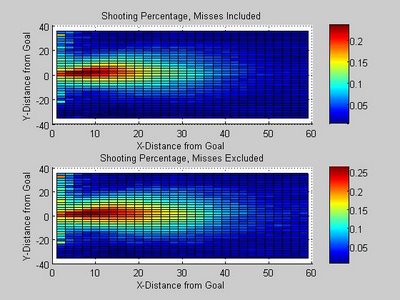
We can see where the estimate error is largest by subtracting the dataset that includes misses from the one that doesn't:
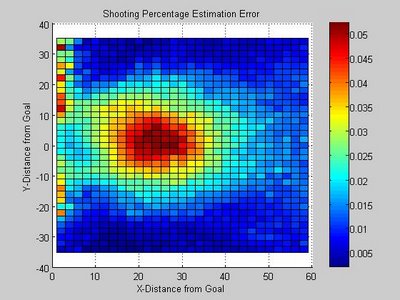
So by failing to include missed shots, we've substantially overestimated the shooting percentage in the high slot, 20 to 30 feet out from the goal. We can also express the error as a percentage:
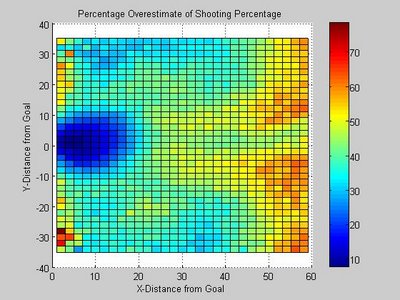
This gives a different result - shots from the blue line are much less likely to go in than we would otherwise think. If we had location data for shots that get blocked (we only know where they were blocked, not where they were shot from), we'd probably find that we're making an even larger overestimate.

We can see where the estimate error is largest by subtracting the dataset that includes misses from the one that doesn't:

So by failing to include missed shots, we've substantially overestimated the shooting percentage in the high slot, 20 to 30 feet out from the goal. We can also express the error as a percentage:

This gives a different result - shots from the blue line are much less likely to go in than we would otherwise think. If we had location data for shots that get blocked (we only know where they were blocked, not where they were shot from), we'd probably find that we're making an even larger overestimate.
Labels: Shooting
Friday, April 24, 2009
2008-09 5v5 Goaltender Performance
Last year, I posted my methodology for calculating the quality of shots faced by a goaltender, along with the results of this analysis.
The 2008-09 results are below (minimum 700 minutes played at 5v5). The last column, DELTAGAA, shows how much lower a goaltender's Goals-Against-Average was than we would expect it to be given the shots he faced. Henrik Lundqvist, Tim Thomas and Jonas Hiller are the only goaltenders who appear in the Top 10 both this year and last year.
At any rate, here are the top 10:
Full stats for this season and last available at: http://www.behindthenet.ca/2008/5_on_5_goalie_shot_quality.php?sort=10
The 2008-09 results are below (minimum 700 minutes played at 5v5). The last column, DELTAGAA, shows how much lower a goaltender's Goals-Against-Average was than we would expect it to be given the shots he faced. Henrik Lundqvist, Tim Thomas and Jonas Hiller are the only goaltenders who appear in the Top 10 both this year and last year.
At any rate, here are the top 10:
NAME GP SPCT GAA ExSPT ExGAA DELTAGAA
TIM THOMAS 54 937 1.87 911 2.64 -0.77
NIKOLAI KHABIBULIN 42 927 1.94 902 2.64 -0.70
ROBERTO LUONGO 54 931 1.90 906 2.59 -0.69
HENRIK LUNDQVIST 69 913 2.38 890 3.00 -0.63
TOMAS VOKOUN 59 931 2.25 913 2.84 -0.59
KARI LEHTONEN 46 917 2.73 900 3.29 -0.56
JONAS HILLER 46 927 1.90 906 2.46 -0.56
MARTIN BRODEUR 31 930 1.90 912 2.38 -0.49
CRAIG ANDERSON 31 922 2.62 909 3.09 -0.47
MANNY FERNANDEZ 28 921 2.18 905 2.64 -0.45
Full stats for this season and last available at: http://www.behindthenet.ca/2008/5_on_5_goalie_shot_quality.php?sort=10
Labels: Goaltending, Shooting
Sunday, June 15, 2008
2007-08 5v5 Goaltender Performance (Full Season)
I finally ran the full-season's worth of shot quality/goaltending statistics (see Mid-Season stats.) There was some discussion over at James Mirtle's site, with some people claiming that Evgeni Nabokov was deserving of the Vezina Trophy - and not Martin Brodeur. The stats don't bear that out:
Brodeur faced tougher shots than Nabokov, and did a way better job of stopping them. There's no way to argue from a shot quality perspective that Nabokov deserves the award.
Here's the rest of the league, minimum 20 GP:
Nabokov Expected Save PCT 909, Actual 908 - GAA 0.03 higher than average goaltender
Brodeur Expected Save PCT 906, Actual 920 - GAA 0.34 *lower* than average goaltender
Brodeur faced tougher shots than Nabokov, and did a way better job of stopping them. There's no way to argue from a shot quality perspective that Nabokov deserves the award.
Here's the rest of the league, minimum 20 GP:
GP TOI SOG GA SPCT GAA EGA ESPT EGAA DELTAGAA
DUBIELEWICZ20 787:01 394 31 921 2.36 41.1 895 3.13 -0.77
LUNDQVIST 72 3063:24 1201 99 917 1.94 137 885 2.68 -0.74
GIGUERE 58 2287:15 1001 65 935 1.71 92.97 907 2.44 -0.73
HILLER 23 863:21 354 27 923 1.88 37.02 895 2.57 -0.7
FLEURY 35 1285:49 614 41 933 1.91 53.92 912 2.52 -0.6
THOMAS 57 2465:18 1186 83 930 2.02 105.8 910 2.58 -0.56
CONKLIN 33 1311:57 714 47 934 2.15 58.5 918 2.68 -0.53
BRYZGALOV 64 2578:31 1266 91 928 2.12 112.3 911 2.61 -0.5
PRICE 41 1669:29 837 63 924 2.26 75.77 909 2.72 -0.46
LEHTONEN 48 1953:15 1066 88 917 2.7 102.2 904 3.14 -0.43
HUET 52 2170:39 1013 77 923 2.13 91.53 909 2.53 -0.4
BRODEUR 77 3392:35 1386 110 920 1.95 129.5 906 2.29 -0.34
LEGACE 66 2616:37 1084 88 918 2.02 102.4 905 2.35 -0.33
HASEK 41 1587:27 545 42 922 1.59 50.68 907 1.92 -0.33
ELLIS 44 1584:18 805 62 922 2.35 70.76 912 2.68 -0.33
TELLQVIST 22 871:55 413 33 920 2.27 37.57 909 2.59 -0.31
KHABIBULIN 50 1943:04 850 77 909 2.38 86.75 897 2.68 -0.3
OSGOOD 43 1728:03 663 58 912 2.01 66.61 899 2.31 -0.3
AULD 32 1199:26 520 42 919 2.1 47.57 908 2.38 -0.28
VOKOUN 69 2910:13 1510 122 919 2.52 134.5 910 2.77 -0.26
LUONGO 73 2908:45 1318 103 921 2.12 115.7 912 2.39 -0.26
GERBER 57 2248:37 1086 94 913 2.51 103.2 905 2.75 -0.24
BIRON 62 2427:39 1241 95 923 2.35 103.5 916 2.56 -0.21
DIPIETRO 63 2631:01 1173 106 909 2.42 114.4 902 2.61 -0.19
LALIME 32 1267:26 561 54 903 2.56 57.76 897 2.73 -0.18
NIITTYMAKI 28 938:43 474 45 905 2.88 47.46 899 3.03 -0.16
THEODORE 53 2243:30 967 87 910 2.33 92.65 904 2.48 -0.15
LABARBERA 45 1721:56 945 86 908 3.00 90.3 904 3.15 -0.15
TOSKALA 66 2720:58 1201 111 907 2.45 116.6 902 2.57 -0.12
KIPRUSOFF 76 3087:15 1379 118 914 2.29 123.7 910 2.40 -0.11
WARD 69 2718:41 1233 113 908 2.49 117.6 904 2.60 -0.1
LECLAIRE 54 2075:24 880 67 923 1.94 70.49 919 2.04 -0.1
TURCO 62 2556:30 1022 91 910 2.14 94.91 907 2.23 -0.09
MILLER 76 3130:07 1399 122 912 2.34 125.8 910 2.41 -0.07
BUDAJ 35 1405:13 587 52 911 2.22 52.53 910 2.24 -0.02
BACKSTROM 58 2441:35 1110 90 918 2.21 89.42 919 2.20 0.01
NABOKOV 77 3266:15 1190 109 908 2 10 7.49 909 1.97 0.03
NORRENA 37 1359:34 548 57 895 2.52 53.55 902 2.36 0.15
HARDING 29 1141:15 578 54 906 2.84 51.01 911 2.68 0.16
RAMO 22 954:17 453 46 898 2.89 43.27 904 2.72 0.17
MASON 51 1902:51 850 86 898 2.71 80.27 905 2.53 0.18
SABOURIN 24 854:58 383 38 900 2.67 35.36 907 2.48 0.19
KOLZIG 54 2292:20 929 98 894 2.57 89.88 903 2.35 0.21
SMITH 34 1433:34 597 64 892 2.68 58.21 902 2.44 0.24
ROLOSON 43 1670:23 795 79 900 2.84 71.72 909 2.58 0.26
EMERY 31 1205:08 505 52 897 2.59 46.44 908 2.31 0.28
GARON 47 1848:13 882 87 901 2.82 78.14 911 2.54 0.29
HEDBERG 36 1384:59 676 73 892 3.16 64.26 904 2.78 0.38
HOLMQVIST 47 1932:04 760 91 880 2.83 68.73 909 2.13 0.69
TOIVONEN 23 842:20 359 51 857 3.63 38.76 892 2.76 0.87
Labels: Goaltending, Shooting
Friday, December 28, 2007
Zetterberg vs Lecavalier defensively
There was a particularly insightful post over at Irreverent Oiler Fans comparing Henrik Zetterberg to Vincent Lecavalier. The gist of it is that their offensive stats may be comparable, but when you look at both +/- and shots directed at the net, Lecavalier is very weak defensively compared to Zetterberg.
If I run the 5v5 shot analysis from below on these two, I get something like this:
EXP GA is the expected number of goals allowed by each player, assuming a league average goaltender. EXP SPCT is the expected save percentage under those same conditions.
Two things come out of this data:
1) Lecavalier gives up a lot more shots on goal when he's on the ice than Zetterberg.
2) The shots Lecavalier gives up aren't better shots, but Tampa's goaltending is a lot worse than average, so it looks like opponents score a lot more when he's on the ice.
I think this is the best way to visualize the situation:
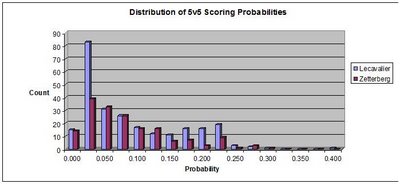
Lecavalier leads Zetterberg in two major categories of shots allowed: very high percentage shots (20% chance of scoring, usually within 10 feet of the goal) and low percentage shots (2.5% chance of scoring). Those two cases cancel each other out, so overall, the average opponent shot when Lecavalier is on the ice isn't any tougher for the goalie to handle. This shows up in the minimal difference in expected save percentage.
But that doesn't change the fact that Lecavalier simply allows a lot more shots when he's on the ice, and even if they're not tough to handle, he's going to allow a lot more goals than Zetterberg.
If I run the 5v5 shot analysis from below on these two, I get something like this:
| Player | GA | SA | SPCT | EXP GA | EXP SPCT |
| Lecavalier | 31 | 229 | 865 | 22.55 | 902 |
| Zetterberg | 16 | 164 | 902 | 14.37 | 912 |
EXP GA is the expected number of goals allowed by each player, assuming a league average goaltender. EXP SPCT is the expected save percentage under those same conditions.
Two things come out of this data:
1) Lecavalier gives up a lot more shots on goal when he's on the ice than Zetterberg.
2) The shots Lecavalier gives up aren't better shots, but Tampa's goaltending is a lot worse than average, so it looks like opponents score a lot more when he's on the ice.
I think this is the best way to visualize the situation:

Lecavalier leads Zetterberg in two major categories of shots allowed: very high percentage shots (20% chance of scoring, usually within 10 feet of the goal) and low percentage shots (2.5% chance of scoring). Those two cases cancel each other out, so overall, the average opponent shot when Lecavalier is on the ice isn't any tougher for the goalie to handle. This shows up in the minimal difference in expected save percentage.
But that doesn't change the fact that Lecavalier simply allows a lot more shots when he's on the ice, and even if they're not tough to handle, he's going to allow a lot more goals than Zetterberg.
Labels: Shooting
Thursday, December 20, 2007
Shooting Percentage by Zone
I spend a lot of time looking at the NHL's data feed, and sometimes I forget that there's often more data available on ESPN's feed. In particular, while the NHL still only gives you shot distance but no angle information, this season, ESPN has the coordinates of every shot on goal. Here's last night's Anaheim-Colorado game, for example. This just serves to remind us that there's a lot more data being collected at every game than we could possibly imagine just from what's publicly-available.
At any rate, one of the things we'd like to know is how often a shot goes in from a given zone on the ice. This plot shows that percentage for even-strength and power-play situations:
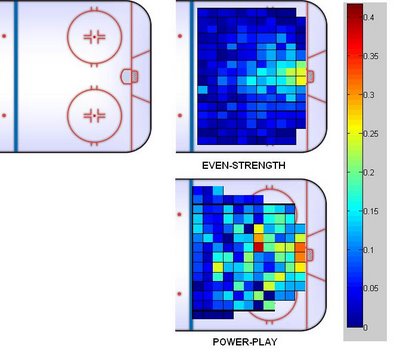
Note that if there were fewer than 20 shots taken so far this season in a given zone, it is not shown. Obviously, there's a tremendous amount we can do with this data, and I'm hoping to get around to that as soon as possible. In the interim, here are some sample shooting scatterplots, starting with the much-maligned Michael Ryder's even-strength shooting:
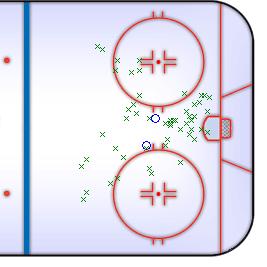
Compare to the somewhat inefficient Alexander Ovechkin at evens:
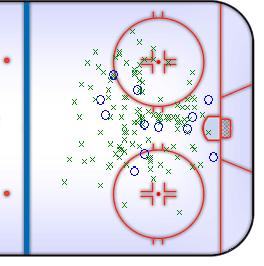
That's all for now. Much more later. If there's any shooting analysis you'd like to see, please post a comment.
At any rate, one of the things we'd like to know is how often a shot goes in from a given zone on the ice. This plot shows that percentage for even-strength and power-play situations:
Note that if there were fewer than 20 shots taken so far this season in a given zone, it is not shown. Obviously, there's a tremendous amount we can do with this data, and I'm hoping to get around to that as soon as possible. In the interim, here are some sample shooting scatterplots, starting with the much-maligned Michael Ryder's even-strength shooting:
Compare to the somewhat inefficient Alexander Ovechkin at evens:
That's all for now. Much more later. If there's any shooting analysis you'd like to see, please post a comment.
Labels: Shooting
Monday, December 3, 2007
Lay off Patrick Marleau
San Jose Sharks Captain Patrick Marleau has been taking a lot of flak for his play this year, and it's true, it all you looked at were his most basic stats, it doesn't seem like he's having a good year:
YEAR TEAM GP G A PTS SOG SPCT ESG ESA PPG PPA
2005-2006 SAN 82 34 52 86 260 13.1 14 28 20 24
2006-2007 SAN 77 32 46 78 180 17.8 18 23 14 23
2007-2008 SAN 24 4 7 11 46 8.7 4 3 0 4
But we can't honestly believe Marleau will continue to score on just 8.7% of his shots, half of his career level, can we? When questioned by the San Jose Mercury News, Marleau doesn't believe it:
"The puck just isn't going into the net," Marleau said. "It's just one of those things that comes and goes. But it's not going to stay this way..."
One thing Marleau does exceedingly well is draw penalties. He was the best in the league (per 60 minutes) last season, and he's the best this season. And it's not even close. He draws penalties with speed and great moves - and that hasn't changed. There is no reason to think Marleau won't rack up a ton of points both at even-strength and on the power-play going forward.
YEAR TEAM GP G A PTS SOG SPCT ESG ESA PPG PPA
2005-2006 SAN 82 34 52 86 260 13.1 14 28 20 24
2006-2007 SAN 77 32 46 78 180 17.8 18 23 14 23
2007-2008 SAN 24 4 7 11 46 8.7 4 3 0 4
But we can't honestly believe Marleau will continue to score on just 8.7% of his shots, half of his career level, can we? When questioned by the San Jose Mercury News, Marleau doesn't believe it:
"The puck just isn't going into the net," Marleau said. "It's just one of those things that comes and goes. But it's not going to stay this way..."
One thing Marleau does exceedingly well is draw penalties. He was the best in the league (per 60 minutes) last season, and he's the best this season. And it's not even close. He draws penalties with speed and great moves - and that hasn't changed. There is no reason to think Marleau won't rack up a ton of points both at even-strength and on the power-play going forward.
Subscribe to Posts [Atom]
